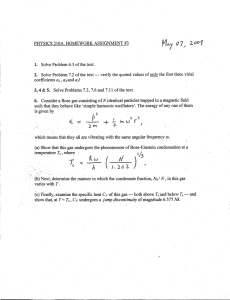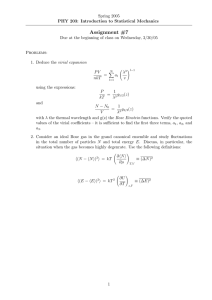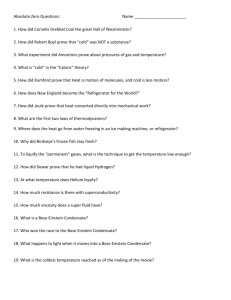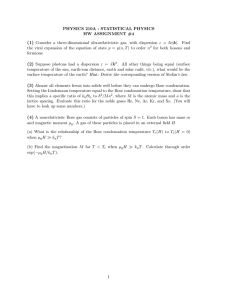VII.G Superfluid He
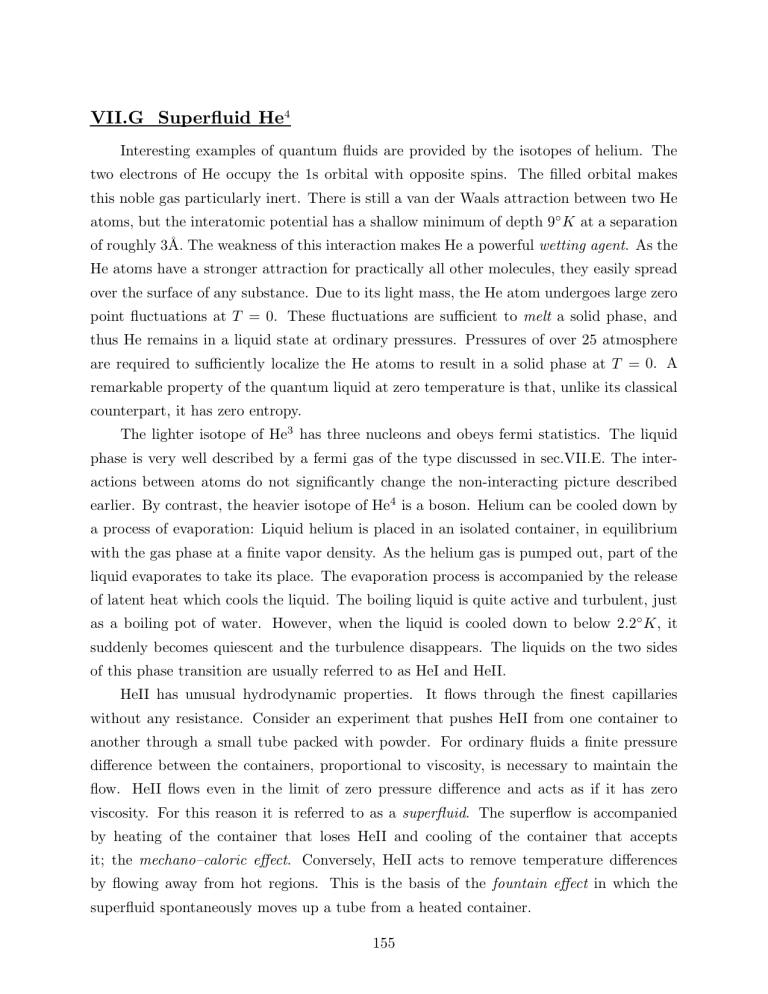
VII.G Superfluid He
4
Interesting examples of quantum fluids are provided by the isotopes of helium. The two electrons of He occupy the 1s orbital with opposite spins. The filled orbital makes this noble gas particularly inert. There is still a van der Waals attraction between two He atoms, but the interatomic potential has a shallow minimum of depth 9 ◦ K at a separation of roughly 3˚ wetting agent . As the
He atoms have a stronger attraction for practically all other molecules, they easily spread over the surface of any substance. Due to its light mass, the He atom undergoes large zero point fluctuations at T = 0. These fluctuations are sufficient to melt a solid phase, and thus He remains in a liquid state at ordinary pressures. Pressures of over 25 atmosphere are required to sufficiently localize the He atoms to result in a solid phase at T = 0. A remarkable property of the quantum liquid at zero temperature is that, unlike its classical counterpart, it has zero entropy.
The lighter isotope of He 3 has three nucleons and obeys fermi statistics. The liquid phase is very well described by a fermi gas of the type discussed in sec.VII.E. The inter actions between atoms do not significantly change the non-interacting picture described earlier. By contrast, the heavier isotope of He 4 is a boson. Helium can be cooled down by a process of evaporation: Liquid helium is placed in an isolated container, in equilibrium with the gas phase at a finite vapor density. As the helium gas is pumped out, part of the liquid evaporates to take its place. The evaporation process is accompanied by the release of latent heat which cools the liquid. The boiling liquid is quite active and turbulent, just as a boiling pot of water. However, when the liquid is cooled down to below 2 .
2 ◦ K , it suddenly becomes quiescent and the turbulence disappears. The liquids on the two sides of this phase transition are usually referred to as HeI and HeII.
HeII has unusual hydrodynamic properties. It flows through the finest capillaries without any resistance. Consider an experiment that pushes HeII from one container to another through a small tube packed with powder. For ordinary fluids a finite pressure difference between the containers, proportional to viscosity, is necessary to maintain the flow. HeII flows even in the limit of zero pressure difference and acts as if it has zero viscosity. For this reason it is referred to as a superfluid . The superflow is accompanied by heating of the container that loses HeII and cooling of the container that accepts it; the mechano–caloric effect . Conversely, HeII acts to remove temperature differences by flowing away from hot regions. This is the basis of the fountain effect in which the superfluid spontaneously moves up a tube from a heated container.
155
In some other circumstances HeII behaves as a viscous fluid. A classical method for measuring the viscosity of a liquid is via torsional oscillators: A collection of closely spaced disks connected to a shaft is immersed in the fluid and made to oscillate. The period of oscillations is proportional to the moment of inertia, which is modified by the quantity of fluid that is dragged by the oscillator. This experiment was performed on HeII by Andronikashvilli who indeed found a finite viscous drag. Furthermore, the changes in the frequency of the oscillator with temperature indicate that the quantity of fluid that is dragged by the oscillator starts to decrease below the transition temperature. The measured normal density vanishes as T → 0, approximately as T 4 .
In 1938, Fritz London suggested that a good starting hypothesis is that the transition to the superfluid state is related to the Bose–Einstein condensation. This hypothesis can account for a number of observations:
(1) The critical temperature of an ideal bose gas of volume v = 46 .
A per particle is obtained from eq.(VII.55) as
T c
= h 2
2 πm
He k
B v ζ
3 / 2
− 2 / 3
≈ 3 .
14 ◦ K.
(VII .
68)
The actual transition temperature of T c
≈ 2 .
18 ◦ K is not far from this value.
(2) The origin of the transition has to be related to quantum statistics as He 3 , which is atomically similar, but a fermion, does not have a similar transition. (Actually He 3 does become superfluid but at temperatures of only a few m ◦ K . This follows a pairing of He 3 atoms which changes their statistics.)
(3) A bose condensate can account for the observed thermo–mechanical properties of
HeII. The expression for pressure in eq.(VII.56) is only a function of temperature, and not density. As such, variations in pressure are accompanied by changes in temperature. This is also the reason for the absence of boiling activity in HeII. Bubbles nucleate and grow in a boiling liquid at local hot spots. In an ordinary fluid, variations in temperature relax to equilibrium only through the slow process of heat diffusion . By contrast if the local pressure is a function of temperature only, there will be increased pressure at a hot spot.
The fluid flows in response to pressure gradients and removes them very rapidly (at the speed of sound in the medium).
(4) Hydrodynamic behavior of HeII can be explained by Tisza’s two–fluid model , which postulates the coexistence of two components for T < T
C
:
(a) A normal component of density ρ n
, moving with velocity ~v n
, and having a finite entropy density s n
.
156
(b) A superfluid component of density ρ s
, which flows without viscosity and with no vorticity ( ∇ × ~u s
= 0), and has zero entropy density, s s
= 0.
In the super-leak experiments, it is the superfluid component that passes through, reduc ing the entropy and hence temperature. In the Andronikashilli experiment, the normal component sticks to the torsional oscillator and gets dragged by it. This experiment thus gives the ratio of ρ n to ρ s
.
There are, however, many important differences between superfluid helium and the ideal bose condensate:
(1) Interactions certainly play an important role in the liquid state. The Bose–Einstein condensate has infinite compressibility, while HeII has a finite density, related to atomic volume, and is essentially incompressible.
(2) It can be shown that, even at T = 0, the ideal bose condensate is not superfluid. This is because the low energy spectrum, E (
~k
) = ¯
2 k 2 / 2 m , admits too many excitations. Any external body moving through such a fluid can easily lose energy to it by exciting these modes, leading to a finite viscosity.
(3) The detailed functional forms of the heat capacity and superfluid density are very different from their counterparts in the ideal bose condensate. The measured heat capacity diverges at the transition with a characteristic shape similar to a λ , and vanishes at low temperatures as T 3 (compared to T 3 / 2 for the ideal bose gas). The superfluid density obtained in the Andronikashvilli experiment vanishes as ( T c
− T ) 2 / 3 the normal component vanishes as approximately T 4 at the transition, while as T → 0 (compared to T 3 / 2 for the condensate density in eq.(VII.53)). Understanding the nature of the singular behavior close to T c is beyond the scope of this discussion. The behavior close to zero temperature, however, suggests a different spectrum of low energy excitations.
Based on the shape of the experimentally measured heat capacity, Landau suggested that the spectrum of low energy excitations is actually similar to that of phonons. This is a consequence of the interactions between the particles. The low energy excitations of a classical liquid are longitudinal sound waves. (In comparison, a solid admits three such excitations, two transverse and one longitudinal.) The correspondence principle suggests that quantized versions of such modes should also be present in a quantum liquid. As in the case of phonons, a linear spectrum of excitations leads to a heat capacity that vanishes as T 3 . The speed of sound waves can be computed from the coefficient of the
T 3 dependence as v ≈ 240 ms − 1 . A further anomaly in heat capacity can be explained by assuming that the spectrum of excitations bends down and has a minimum in the vicinity
157
of a wavenumber k
0
≈ A − 1 . The excitations in the vicinity of this minimum are referred to as rotons , and have an energy
E roton
(
~k
) = Δ +
¯
2
2 µ
( k − k
0
) 2 , (VII .
69) with Δ ≈ 8 .
6 ◦ K , and µ ≈ 0 .
16 m
He
. The spectrum postulated by Landau was confirmed directly by neutron scattering measurements in the 1950’s.
158
MIT OpenCourseWare http://ocw.mit.edu
8.333
Statistical Mechanics I: Statistical Mechanics of Particles
Fall 2013
For information about citing these materials or our Terms of Use, visit: http://ocw.mit.edu/terms .
